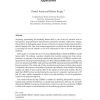Free Online Productivity Tools
i2Speak
i2Symbol
i2OCR
iTex2Img
iWeb2Print
iWeb2Shot
i2Type
iPdf2Split
iPdf2Merge
i2Bopomofo
i2Arabic
i2Style
i2Image
i2PDF
iLatex2Rtf
Sci2ools
RAS
2008
2008
Motion intention recognition in robot assisted applications
Acquiring, representing and modeling human skills is one of the key research areas in teleoperation, programming-by-demonstration and human-machine collaborative settings. The problems is challenging mainly because of the lack of a general mathematical model to describe human skills. One of the common approaches is to divide the task that the operator is executing into several subtasks or low-level subsystems in order to provide manageable modeling. In this paper we consider the use of a Layered Hidden Markov Model (LHMM) to model human skills. We evaluate a gesteme classifier that classifies motions into basic actionprimitives, or gestemes. The gesteme classifiers are then used in a LHMM to model a teleoperated task. The proposed methodology uses three different HMM models at the gesteme level: one-dimensional HMM, multi-dimensional HMM and multi-dimensional HMM with Fourier transform. The online and off-line classification performance of these three models is evaluated with respect ...
Related Content
| Added | 28 Dec 2010 |
| Updated | 28 Dec 2010 |
| Type | Journal |
| Year | 2008 |
| Where | RAS |
| Authors | Daniel Aarno, Danica Kragic |
Comments (0)

